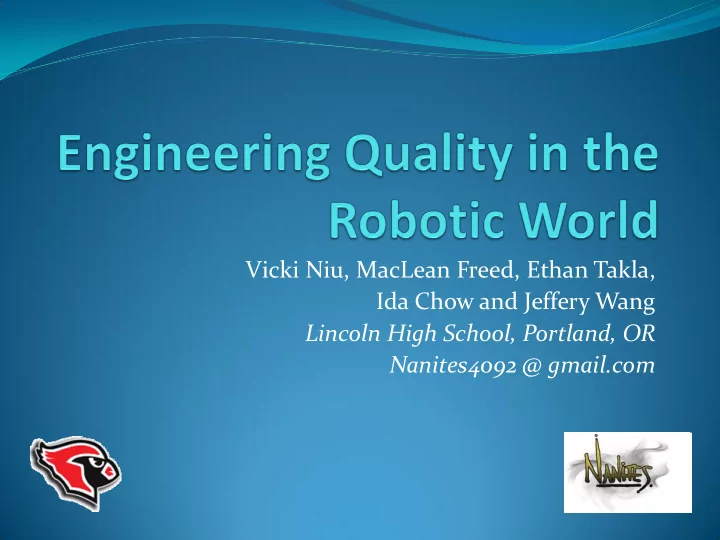

Vicki Niu, MacLean Freed, Ethan Takla, Ida Chow and Jeffery Wang Lincoln High School, Portland, OR Nanites4092 @ gmail.com
Outline Learning STEM through robotics Our journey from FIRST LEGO League to FIRST Tech Challenge Robotics as a case study for engineering quality What we learned
Learning STEM through Robotics Through FIRST, we have been working together since 2005, when we were just 4 th graders We’ve learned about science, technology, engineering and mathematics (STEM) through robotics competitions. We learned to work together as a team. Here, we are going to share the story of how we approach engineering quality in the robotic world.
2010: FLL World Festival in Atlanta
2012 FTC Oregon State Championship
LEGO Robots
A LEGO Program
What we learned from FLL Navigation based on time vs. sensor based navigation Efficiency of actions due to time limit Creative use of basic parts Using mathematics within programming
“FIRST TECH Challenge” Experience High school program Started freshman year Chance to expand on what was learned in the previous program Oregon has ~100 teams
Competition Video
Why is robotics a good case study? Must adapt to a changing environment Collisions with other robots
Why is robotics a good case study? Must adapt to a changing environment Mobile field components
Why is robotics a good case study? Must adapt to a changing environment Varying field surfaces, lighting, power Robot hardware and software are easily adaptable Restraints placed on both hardware and software capabilities
Hardware Restrictions Robot design process Limitation of resources Manipulation of materials Testing (durability under stress)
Advantages of TETRIX Manipulation Customization Varied uses Compatibility
CAD Analyzes designs Saves prototype costs Uses software to test real-life situations Smoother construction
Sensor unreliability Sensors have error, lack accuracy Values can deviate from “true” reading 40 Actual Yaw vs. Hitechnic Compass Sensor Yaw Ultrasonic Sensor Reading 35 Gyroscope integrated drift 400 30 Yaw (Degrees) 300 25 (cm) 20 Actual Yaw 200 15 100 10 Yaw from Hitechnic Compass Sensor 5 0 0 1 36 71 106 141 176 211 246 281 316 351 386 421 456 491 526 0 10 20 30 40 Sample Number Actual Distance Until Wall (cm)
Insufficient sensor information Missions are complex, require detailed information Sensors can be reliable but provide data that isn’t useful
Needed sensor information 40 Orientation Ultrasonic Sensor Reading (cm) 35 Compass sensor 30 Magnetometer Hitechnic Compass Sensor Yaw vs. Robot Pitch 25 Position Magnetometer Y Axis vs. 200 X axis 20 Ultrasonic sensor Degrees 100 Pitch 15 0.6 Milligauss (y axis) 10 Hitechnic Compass 0 0.4 1 40 79 118 157 196 235 274 313 352 391 430 469 508 Sensor Yaw 5 0.2 -100 0 Sample Number 0 10 20 30 40 0 Actual Distance Until Wall (cm) -0.8 -0.6 -0.4 -0.2 0 0.2 Milligauss (x axis)
Attitude and heading reference system + Rotation Matrix – Gyro XYZ Attitude - Kinematics & Normalization Magnetometer PI Drift Controller Detection Accelerometer Compensate for gyro drift with direction cosine matrix (DCM) using fused magnetometer and accelerometer data Consolidated into AHRS Fuses accelerometer, magnetometer, and gyro data Return roll, pitch, yaw
Attitude and heading reference system 200 AHRS Yaw 150 100 Degrees AHRS Pitch 50 0 1 61 121 301 361 421 481 181 241 Hitechnic -50 Compass Sensor Yaw -100 Sample Number
Image tracking using cameras Need position data as well as orientation data Use two cameras to attain visual data using a semi- global block matching (SGBM) algorithm
Semi-global block matching Calibrate cameras to account for distortion or offset Two cameras, left and right, take images simultaneously
Summary Through the case study of robotics competition, we examined what we learned in engineering quality. Teamwork is critical to achieving engineering quality. Having fun helps too! Mechanical design. Overcoming sensor limitations Exploring navigation techniques, e.g. AHRS, 3D camera tracking.
Acknowledgements Richard Vireday Aaron Akzin Lincoln High School ORTOP Community FIRST Fourmost Products
References FIRST LEGO League, “Food Factor Challenge,” [Online], Available: http://firstlegoleague.org/sites/default/files/Challenge/FoodFactor/FLL2011_Complete_Challenge.pdf FIRST Tech Challenge, “Bowled Over! Challenge,” [Online], Available: http://www.usfirst.org/sites/default/files/uploadedFiles/Robotics_Programs/FTC/Game_Info/2011/Complete-Build-Guide.pdf FIRST Tech Challenge, “Bowled Over! Game Manual,” [Online], Available: http://www.usfirst.org/sites/default/files/uploadedFiles/Robotics_Programs/FTC/Game_Info/2011/Bowled-Over-Game- Manual_Rev%285%29.pdf RobotC , “ RobotC NXT Curriculum,” [Online], Available: http://www.robotc.net/education/curriculum/nxt/ V. M. B. K. Pirabakaran , “PID Autotuning Using Neural Networks and Model Reference Adaptive Control,” Proceedings of the 15th IFAC World Congress, 2002 , 2002. [Online]. Available: http://www.nt.ntnu.no/users/skoge/prost/proceedings/ifac2002/data/content/01467/1467.pdf. [Accessed: 15-Jun-2012]. W.-yong Han, J.-wook Han, and C.- goo Lee, “Development of a Self -tuning PID Controller based on Neural Network for Nonlinear Systems,” Control , pp. 979-988, 1999. F. Lin, R. D. Brandt, and G. Saikalis , “Self - tuning of PID controllers by adaptive interaction,” Proceedings Of The American Control Conference , vol. 5, no. June. American Autom. Control Council, pp. 3676-3681, 2000. D. Brutzman , “From virtual world to reality: designing an autonomous underwater robot,” 1992. Y. Kuroda, K. Aramaki, and T. Ura , “AUV test using real/virtual synthetic world,” Proceedings of Symposium on Autonomous Underwater Vehicle Technology , pp. 365-372. S. O. H. Madgwick , “An efficient orientation filter for inertial and inertial / magnetic sensor arrays,” Report xio and University of Bristol UK, vol. 2011, p. 1--32, 2010. Oliver J. Woodman, “An introduction to inertial navigation,” University of Cambridge, p. 1 --37, 2007.
Questions? For any further questions, you can contact us at: nanites4092@gmail.com http://nanites.zymichost.com
Recommend
More recommend